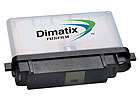
Imagine manufacturing methods that operate at microscopic scales and are versatile enough to produce flexible printed electronics, photovoltaic structures, flat-panel displays, backplanes, RFIDs, smart tags, sequences of genetic material, or chemical and biological sensors.
Welcome to materials deposition, the new frontier in high-technology manufacturing, where the materials deposited can range from UV-curable light-emitting polymers and conductive fluids to organic “inks” and DNA, and the thickness often must be controlled to within a few ten-millionths of a meter.
It’s also where drop-on-demand inkjet, or Piezo DOD - a technology traditionally associated with wide-format printing - is quickly finding acceptance on the materials-deposition scene as a viable and often valuable manufacturing method.

Inkjet: The Perfect Deposition Technology
Broadly defined, the practice of materials deposition involves any method used to deposit a thin film of material onto a substrate or previously deposited layers on a substrate.Piezo DOD inkjet for graphics printing certainly fits this basic definition. Graphics printing involves depositing thin films of ink to form text and images of various colors on paper, vinyl or similar substrates, thereby producing a visual experience.
Piezo DOD inkjet printheads are also fast and accurate. For example, precision-manufactured FUJIFILM Dimatix Spectra®printheads can jet inks for industrial printing applications at frequencies exceeding 20,000 cycles/second (20 kHz) and at print speeds of 1.5 meters per second. Each nozzle can fire ink droplets on demand, simultaneously on each cycle and virtually without “crosstalk,” straight and true to their intended targets.
Piezo DOD inkjet can also eliminate manufacturing steps and reduces consumable usage and chemical waste. As a digital technology, inkjet production startup costs are comparatively low, and expensive materials like liquid silver and DNA are optimized by jetting them only where they’re needed.

A Quantum Leap
To compete in the rarefied atmosphere of high-technology process manufacturing, Piezo DOD must be considerably more precise than the technology used for producing print.For example, materials deposition demands droplet-sized tolerances exceeding those used for print production by orders of magnitude. Instead of jetting ink at the 30-80 picoliter droplet sizes common to print production, high-technology materials deposition routinely requires fluid “drop” sizes of 10 picoliters (10 trillionths of a liter), and often 1 pL or less.
High-tech materials deposition also requires inkjet printheads to handle a comparatively wide variety of fluids for a virtually unlimited range of applications, onto a broader range and type of substrates, and at temperatures that often must be controlled more closely (see Table, p. 21). Traditional Piezo DOD inkjet, in short, had to take a quantum leap to be suitable for handling high-tech materials deposition.
The Shaped Piezo Silicon MEMS Breakthrough
FUJIFILM Dimatix (then known as Spectra Inc.) introduced its Shaped Piezo SiliconTMMEMS fabrication technology at Drupa in 2004. MicroElectroMechanical Systems (MEMS) is an advanced manufacturing method that uses techniques similar to those used in fabricating integrated circuits to create ultra-miniature inkjet structures within silicon.In developing this method, FUJIFILM Dimatix took MEMS technology one step further. By manufacturing an entire printhead assembly on a silicon wafer - basically a printhead on a chip - the Shaped Piezo Silicon method produced a new generation of printheads capable of supporting a range of fluids, from traditional inks to various functional fluids such as nanoparticle-based metallic materials.
Unlike some deposition methods that flood a surface with functional fluids, inkjet is both precise and additive, able to deposit the exact amount of material at the exact locations where it is needed, without waste. This precision makes it unnecessary to image and pattern, etch and recover waste material, enhancing inkjet’s attractiveness for use with aggressive, conductive, and reactive fluids and coatings that often must be deposited at precision locations and in precisely controlled amounts.
FUJIFILM Dimatix’ advance in manufacturing engineering transformed Piezo DOD from a method primarily suited for industrial print production to one that also offers unique possibilities and advantages for materials deposition and nanotechnology manufacturing.
Building in a New Direction
To commercialize its breakthrough technology, in May 2005 FUJIFILM Dimatix opened its Silicon Valley headquarters, including an Advanced Development Center and silicon MEMS fabrication facility. In June 2005, the company (founded in 1984 as Spectra Inc.) was renamed Dimatix to reflect its expansion into digital materials deposition.The company’s patented Piezo DOD inkjet printheads were already known for their ability to sustainably jet ink and many other fluids precisely and at high frequencies, without trading off drop placement accuracy; and for their high duty cycles and long life - traits that allow OEMs and systems integrators to design advanced systems for industrial print production that are fast, reliable, and economical.
In 2006, FUJIFILM Dimatix was awarded a Nano 50TMAward fromNanotech Briefs®magazine for its Dimatix Materials Printer, placing it in an elite group of technologies, products and innovators that have or will significantly impact key nanotechnology markets, from automotive and electronics to biomedical and materials.
Also in 2006, the company was presented with the first-everSilicon Valley/San Jose Business JournalEmerging Technology Award, which it won in the Biotechnology category for its development of the DMP. The Emerging Technology Awards recognize Silicon Valley companies creating and bringing to market cutting-edge technologies that have the potential to profoundly impact people and businesses.
The strength of FUJIFILM Dimatix’ core inkjet printhead technologies, plus its development of Shaped Piezo Silicon MEMS and the Dimatix Materials Printer and Cartridge, is helping move materials deposition out of the lab and into the mainstream by using new methods to fabricate a new generation of products not possible only a few years ago.
For more information, visit www.dimatix.com.
Spectra is a registered trademark, and Dimatix, Merlin, Shaped Piezo Silicon, and Tapestry are trademarks of FUJIFILM Dimatix Inc.